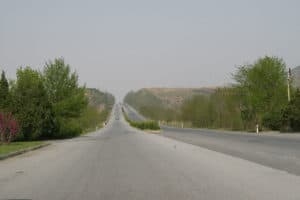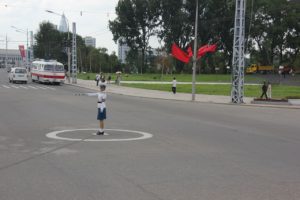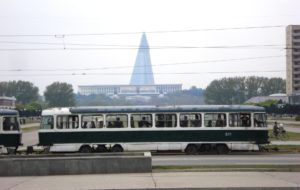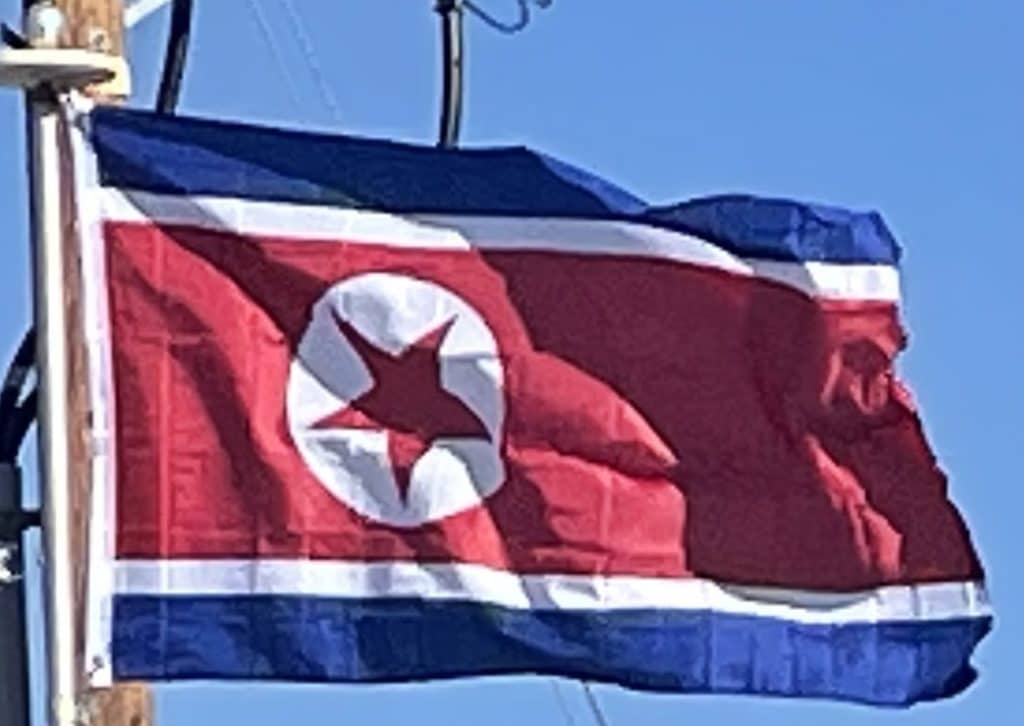
The overwhelming majority of the estimated 264,000 vehicles in use in 1990 were for the military. Rural bus service connects all villages, and cities have bus and tram services. Since 1945/1946, there is right-hand traffic on roads. In cities, driving speeds are set by which lane a driver is in. The speed limits are 40 kilometres per hour (25 mph), 60 kilometres per hour (37 mph), and 70 kilometres per hour (43 mph) for the first, second, and subsequent (if existing) lanes from the right, respectively. A white-on-blue sign informs about this. The leftmost lane, if it is number 3 from the right or higher and is not a turning lane, is often left vacant, even by tourist buses, while the second-from-right lane is generally used to overtake vehicles from lane one, such as public transport buses and trams.
Besides the blue in-city sign, all other occasions, such as motorways and roads outside cities, use the more widely known red-circle-with-number-inside sign to post speed limits. On motorways, the typical limit is 80 kilometres per hour (50 mph) and 100 kilometres per hour (62 mph) for lanes from the right, respectively, as posted on the Pyongyang-Kaesong highway, for example. The rightmost lane of a motorway is sometimes, as seen on the Pyongyang–Myohyang highway, limited to 60 kilometres per hour (37 mph) near on-ramp joining points.

Automobile transportation is further restricted by a series of regulations. According to North Korean exile Kim Ji-ho, unless a driver receives a special permit it is forbidden to drive alone (the driver must carry passengers). Other permits are a military mobilization permit (to transport soldiers in times of war), a certificate of driver training (to be renewed every year), a fuel validity document (a certificate confirming that the fuel was purchased from an authorized source), and a mechanical certificate (to prove that the car is in working order).
As of 2017, electric bicycles are becoming popular in Pyongyang; about 5% of bicycles are electric. Both locally produced and Chinese electric bicycles were available.[12]
There is a mix of locally built and imported trolleybuses and trams in the major urban centres of North Korea. Earlier fleets were obtained from Europe and China.

The Korean State Railway is the only rail operator in North Korea. It has a network of over 6,000 kilometres (3,700 mi) of standard gauge and 400 kilometres (250 mi) of narrow gauge (762 mm or 30.0 in) lines; as of 2007, over 5,400 kilometres (3,400 mi) of the standard gauge (well over 80%), along with 295.5 kilometres (183.6 mi) of the narrow gauge lines are electrified. The narrow gauge segment runs in the Haeju peninsula.
Because of lack of maintenance on the rail infrastructure and vehicles, the travel time by rail is increasing. It has been reported that the 190-kilometre (120 mi) trip from Pyongyang to Kaesong can take up to six hours.
North Korea’s international air connections are limited in frequency and numbers. As of 2011, scheduled flights operate only from Pyongyang’s Pyongyang Sunan International Airport to Beijing, Dalian, Shenyang, Shanghai, Bangkok, Kuala Lumpur, Singapore, Moscow, Khabarovsk, Vladivostok, and Kuwait International Airport. Charters to other destinations operate as per demand. Prior to 1995 many routes to Eastern Europe were operated including services to Sofia, Belgrade, Prague, and Budapest, along with others.
